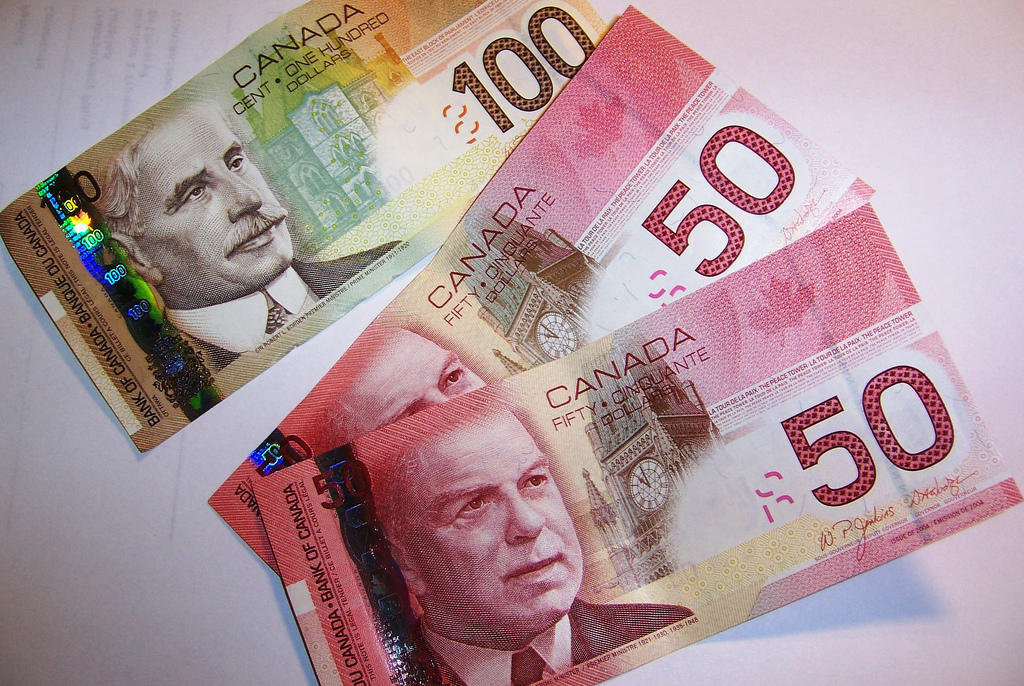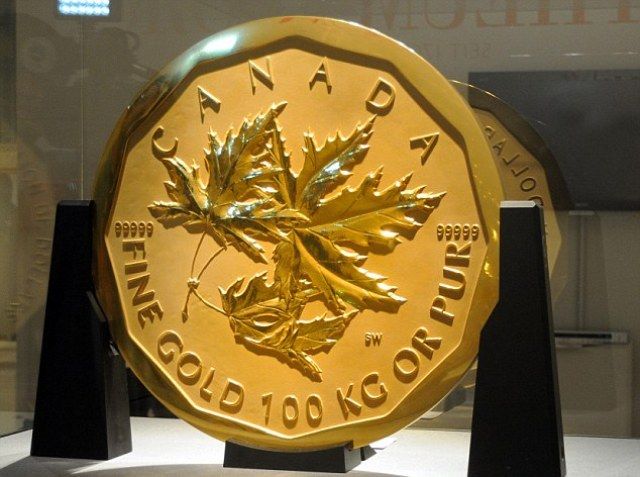Comments Off on China & Russia Buying Gold by the Ton, Canada Has Just Ounces
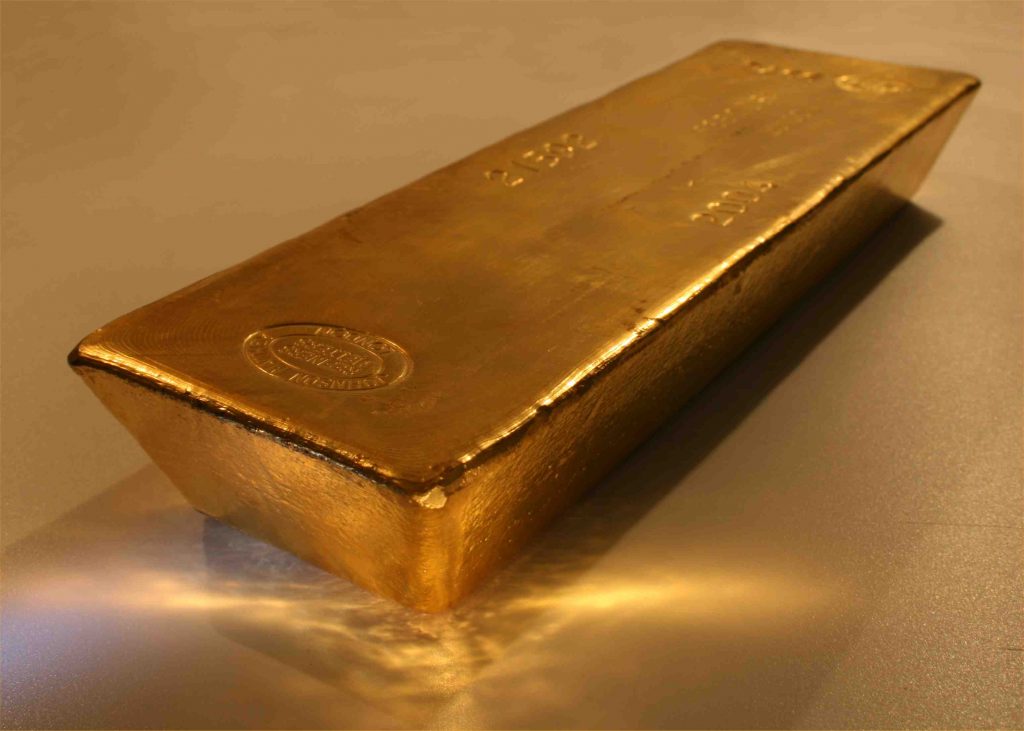
Up until just a few years ago, gold was considered a good investment to make, as the market crash of 2008 was not yet forgotten. This is because gold is regarded as a financial safety net. Recently, with the economy shifting and the currency losing power, more and more people are investing in gold like crazy – and this spreads all the way to entire countries.
The attractiveness of gold shows no abating signs – and many central banks are not slow to catch onto the movement. Still, some countries such as Canada have decided to move in a different, nearly gold-free direction – but data shows that the risks involved in accumulating gold are worth taking.
The Chinese and Russian Gold Rush
Global superpowers such as Russia and China have begun buying gold by the ton, as the bullion reserves of both countries have increased substantially. In 2018, the central bank of Russia bought 276 tons of gold bullion – a quantity that was worth more than 11 billion dollars.
As a result, the rush to gold only kept growing. In February 2019, the Russian gold reserve went up by 1Moz – resulting in the country now accounting for about 40% of gold buying. Around 6% of the global gold demand also belongs to Russia. The purpose is to reduce their reliance on the American dollar and increase the economic growth of the country.
China also makes its attraction for gold known. According to the stats from the People’s Bank of China, the country also managed to boost its gold reserves, reaching a total of 60.62 million ounces in March. This is a very impressive number, considering that in February, it stood at 60.26 million ounces.
March marks the fourth month in a row when China increased its gold purchase. During this time frame, this Asian power managed to add 42 tons of gold to its national reserve. To strengthen this move, gold companies from China have also invested about 4 billion dollars since 2011, boosting the reserves of the country by 800 tons.
China is now loading up on its gold reserve at a rate that is relatively steady. This was revealed in 2015 as gold bullion increased almost every month for a longer time frame. Now, China and Russia are turning this into a competition, moving almost head to head in their gold-purchasing spree. With these continuous purchases, they’re hoping that the reserves will grow enough to lessen their reliance on the U.S. dollar.
A Sharp Contrast with Canada
As we can see, China and Russia are not joking when it comes to gold investments. The power of the US dollar seems to be weakening, and the fact that these two powers have stocked up on gold might prove to be both an investment, as well as a separation from the global superpower called the United States.
In sharp contrast to the tons of gold purchased by Russia and China, we have Canada, which only has 77 ounces at this point. This is quite insignificant compared to the amounts held by the other two countries.
Canada began to sell many of its remaining gold reserves, giving it to the general public. By selling the gold coins this way, they reaped better prices than if they dumped a 400-ounce bar to a banker.
In 2015, the gold reserves of Canada were fairly rich, valued at around 100 million dollars. According to the Bank of Canada, around 21,000 coins (21,929 ounces) were sold in February, causing the gold quantities to go down. Before that, they sold around 38,860 ounces in January, and 41,106 in December 2018. After so much gold was sold, Canada was left with the 77 ounces that they had in March – with the numbers dangerously low.
Canada’s official statement was that their decision to sell had nothing to do with a specific gold price. Sales had been going on for quite some time at a steady pace –according to them.
The government has issued a long-standing policy in which they attempt to diversify the portfolio by selling gold and other physical commodities. Instead of gold, they opt to invest in financial assets that could be easily traded and have a great market of both buyers and sellers.
A Potential Shift towards Gold
We see that Canada has not gotten caught up in the gold rush as China and Russia seem to be. However, behind the scenes, the government does realize that they would eventually have to shift from a cash-based society and go for a cashless one. This will allow them to retain economic power.
Still, in order to do that, they will have to separate themselves from the power of the U.S. Still, this fuels the debate that is occurring behind closed doors on how the monetary system should be approached. There is the question of whether the use of this “barbaric relic” is actually needed or not. Is it actually a good idea to invest in Canadian gold coins in this day and age?
Considering the rate at which gold is soaring (and the American dollar dropping), China and Russia seem to have a good idea. Given the economic turmoil through which many countries are going, it is expected that the currency will once again drop – and that the invested gold will start bringing profits. Looking at the stats now, China and Russia would become rich – while Canada will fairly much remain in the same place.
Final Thoughts
Going the socialist route, Canada may have created a dent in their finances. At this point, with their 77 ounces of gold, they’ll never catch up to Russia or China – who already have tons of this precious metal. They know that gold will go up at some point – and in an attempt to shift away from the U.S. dollar, they are giving it their all.
However, by shifting their attention towards mining Canadian gold, Canada might be actually able to reap part of the benefits that China and Russia have. It might take years until Canada also manages to shift away from the dollar – but with careful investment, it can be done.
—
Photo: Bullion Vault
Comments Off on Half of Canadians $200 Away from Broke, 31% Drowning in Debt
If you’re a Canadian with an interest in precious metals investing, consider yourself lucky to be part of an increasingly small club.
It turns out those neighbors that seem to have it all can barely keep up with monthly bills:
More than half of Canadians are living within $200 per month of not being able to pay all their bills or meet their debt obligations, according to a recent Ipsos survey conducted on behalf of accounting firm MNP.
31 percent are sinking in debt a little more every month. 10 percent have just $100 in wiggle room.
House prices are surging, electricity and cellphone bills rank among the worlds highest; it seems Canadians pay more for everything. It’s little wonder how it’s gotten this bad.
However, it’s a weak position to only attribute factors out of ones control. Refusal to adopt lean spending habits and questionable financial literacy are also to blame. The survey also found that “60 per cent said they don’t have a firm grasp of how interest rates affect debt repayments.” Not shocking in the least as you’d have to not understand compound interest to agree to it, or be very desperate.
With an uncanny ability to ignore financial red flags one wonders if even Billionaire investor Warren Buffet in the flesh could straighten them out. He’s often advised:
“The most important thing to do if you find yourself in a hole is to stop digging.”
When CNBC asked him what was the one thing he believed young people should be doing about money, his primary advice was to “stay away from credit cards.” Paying interest on credit cards not only suggests that you are living beyond your means, but it also means that you are losing money. Both courses of action run contrary to Buffett’s philosophy.
Another danger is emerging, and naturally that same uninformed 60 percent won’t see it coming, though they’ll feel it. Variable mortgages are about to skyrocket due to the Bank of Canada’s interest rate hike.
A decision by the BoC to start lifting its key policy rate from historic lows would raise the cost of carrying debt across the country. The Bank uses interest rates, among other tools, to influence inflation and economic activity. Many economists believe it could start to raise rates in the first half of 2018, as economic growth picks up pace.
Isn’t this a cruel trick? Once creditors had the people hooked on cheap credit, they found a way to switch the rules with help from their pals at BoC.
James Laird, president of brokerage firm CanWise Financial has predicted fixed rate mortgages will raise “0.20 to 0.25 of a percentage point.”
This could push the spread between 5-year fixed-rate mortgages and 5-years variable-rate mortgages beyond 1 percentage point, said Laird, a threshold beyond which there is generally a sizable increase in the number of Canadians who will opt for variable rates.
Americans are a little better off, but not by much. CEO of cell phone insurer Assurant noted this on Bloomberg TV:
“The reality is, half of Americans can’t afford to write a $500 check,” Colberg said. We decided to look into the CEO’s claim about the woeful state of US finances. What we found is that according to a recent Bankrate survey of 1,000 adults, 57% of Americans don’t have enough cash to cover a mere $500 unexpected expense.
[Infowars]
Money is working against the average North American, not for them. It’s a difficult cycle to stop, because it’s rooted in a faulty mindset. Frugality, saving and investing isn’t sexy. Photos of expensive vacations get us more likes on social media, and displays of lavish spending give us a quick fix of positive reinforcement in our image-orientated culture. Living for the now is important, but some sacrifice is required for a better future.
Warren Buffett decorated his office with Depression-era photos to remind him that even in times in prosperity you need to prepare for the worst.
Wake up Canada! If a small repair to your aging Hyundai sends your personal balance sheet into the red, it’s time to break free from the herd. Stop borrowing and start investing.
—
Photo: Eric L
Comments Off on Top 6 Significant and Rare Canadian Gold Coins
Canada has a colourful heritage in its gold coinage. On one hand the Royal Canadian Mint makes one of the most coveted gold bullion coins in modern times, and on the other Canada has a track record of circulating gold coins for very brief periods before times of radical change such as the start of WWI or the end of the gold standard.
Originally this was intended to be a top 10 list. However, the Royal Canadian Mint has consistently been issuing collectable gold coins with low mintages and hefty price tags, and only time will tell which of these more recent designs will earn a place in history. Gold coins with the potential for future greatness are listed at the very bottom under honorable mentions.
6. Canadian Gold Maple Leaf (1979-present)
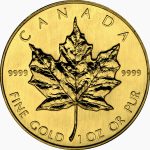 These may not be rare like many of the other coins on this list, but the Canadian Gold Maple Leaf earns its place here for exactly that reason: it’s popularity and importance in the international gold bullion market. According to the ‘AMPEX Top 40’ products, only the Gold American Eagle and Gold Buffalo sold better, shooting ahead of even the staple South African Krugerrand.
These may not be rare like many of the other coins on this list, but the Canadian Gold Maple Leaf earns its place here for exactly that reason: it’s popularity and importance in the international gold bullion market. According to the ‘AMPEX Top 40’ products, only the Gold American Eagle and Gold Buffalo sold better, shooting ahead of even the staple South African Krugerrand.
The other claim to fame is these are the purest mainstream gold bullion coins available with a purity of .9999 since the revision in 1982.
5. The Spirit of Haida Gwaii (2007) – 10 Kg Gold Coin
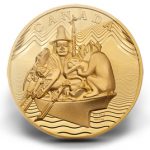 An important landmark for the Royal Canadian Mint, this was the world’s first 99.999% 10-kg pure gold coin. Unlike the million dollar coin made in the same year, it was intended for public release. No more than 15 were produced.
An important landmark for the Royal Canadian Mint, this was the world’s first 99.999% 10-kg pure gold coin. Unlike the million dollar coin made in the same year, it was intended for public release. No more than 15 were produced.
The coin was given the second highest denomination ever by the mint at $100,000. Considering the value of the gold alone it’s currently worth almost $550k CAD!
4. Canadian Gold Sovereigns (1908-1919)
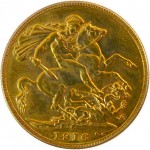 Gold sovereigns have a long history in the UK; the first were minted in 1489 during the reign of Henry VII. Over 400 years later, Canada was the first country outside Britain to issue gold sovereigns starting in 1908.
Gold sovereigns have a long history in the UK; the first were minted in 1489 during the reign of Henry VII. Over 400 years later, Canada was the first country outside Britain to issue gold sovereigns starting in 1908.
The period of minting during the rule of George V, only produced 628,152 Canadian gold sovereigns in total, making all dates rare and in some cases exceptionally scarce. There are fewer than 50 1916 C gold sovereigns still in existence, which makes it one of the rarest and thus valuable Canadian coins.
3. $5 and $10 Bank of Canada Gold Coin (1912-1914)
Historians have noted these briefly minted $5 and $10 gold coins were discontinued and yanked from circulation to stop gold from leaving Canada during World War I. Additionally this is the time Ottawa suspended the gold standard.
In 2013, The Globe and Mail reported that the conservatives had plans to melt down more than over 200,000 coins still owned by the government, and 30,000 would be sold to collectors.
2. $2 Newfoundland Gold Coin (1865-1888)
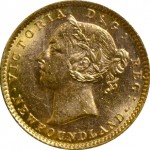 Minted intermittently during the reign of Queen Victoria, it was the only gold coin in circulation issued by a British colony. Newfoundland was self-governed so the choice to issue the coinage of their choice was done independent of the influence of the UK.
Minted intermittently during the reign of Queen Victoria, it was the only gold coin in circulation issued by a British colony. Newfoundland was self-governed so the choice to issue the coinage of their choice was done independent of the influence of the UK.
In April 2014 a Newfoundland gold coin was sold for a record high of $102,812.50 USD at a major auction in Chicago. It was a one-of-a-kind test design for the $2 Newfoundland gold coin which wasn’t chosen.
1. Million Dollar Coin (2007)
With a face value of $1-million and a true market value of at least $5-million according to current gold prices, this giant coin is the king of Canadian gold coinage.
Originally the Royal Canadian Mint made just one to promote its new line of .99999 pure Maple Leaf bullion coins. When buyers with exceptionally deep pockets showed a great interest in getting one, more were minted. Today a total of five are scattered around the world, and one is in a vault in Ottawa.
A million-dollar coin was stolen from a German museum in 2017. Thieves used a three-meter-long ladder to enter the back of the Bode, then carted it away in a wheelbarrow!
Honorable Mentions
In the Eyes of the Timber Wolf – Fourth in the series of wildlife coins with a selective enamel, it weighs in at one-kilogram and is 99.99% pure gold. Only 10 minted in 2017 with a price of $69,000.00!
A Celebration of Her Majesty’s 90th Birthday – The first gold coin to feature 29 Canadian diamonds and a large AAA cabochon emerald at its center. Only 125 minted in 2016 with a price tag of $6,999.95.
90th Anniversary of the Royal Canadian Mint – Just 1,999 minted and originally sold for $999.99 in 1998.
The Golden Slipper (Flower of Prince Edward Island) – .99999 fine, only 1,990 minted and originally sold for $999.99 in 1999. Housed in a fancy gold box; no, not the real kind.
1976 22kt $100 Olympic Commemorative Gold Coin – Two versions were released, one 14kt and the other 22kt. Naturally the 22kt version is worth significantly more.
Comments Off on Canadian Gold Maple Leafs vs American Gold Eagles

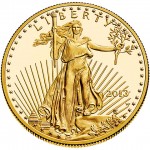 Both the Maple Leaf and American Eagle are among the most widely traded gold bullion coins in the world. You can’t go wrong with either. Subtle differences based on preference and objective criteria may direct you towards one over the other.
Both the Maple Leaf and American Eagle are among the most widely traded gold bullion coins in the world. You can’t go wrong with either. Subtle differences based on preference and objective criteria may direct you towards one over the other.
The first and arguably most significant difference is purity. The Maple Leaf is .9999 pure gold, while the Eagle is .9167 and is the equivalent of 22kt gold.
On paper this makes the maple leaf appear to be the clear winner but purer isn’t always better depending on your preferences. The Maple Leaf is more prone to wear during handling because nearly solid gold is soft as metals go. This shouldn’t be an issue for most however because there is no reason to be handling bullion coins in the first place. If you wish to admire the design put it in coin capsule.
Although popular worldwide, clearly the American Eagle has a slight edge on U.S. soil when it comes to trading and desirability. The same is true of the Maple Leaf on Canadian soil. Internationally it’s extremely close although the Maple Leaf may be a touch better.
Premiums over spot will also very depending on your location. The difference may seem negligible but in finance every dollar counts, especially if you buy in one part of the world and sell in another.
American Gold Eagle Facts
This coin features the same stunning figure of Liberty as the Saint-Gaudens double eagle. Miley Busiek created the reverse design of a soaring eagle in 1986; the same year the American Gold Eagle was introduced.
Face value: $50 USD
Purity: .9167
Mass: 33.930 g (1.0909 troy oz)
Diameter: 32.70 mm
Edge: Reeded
Canadian Gold Maple Leaf Facts
The reverse of the Maple Leaf was designed and first released in 1979. Obverse portrait of Queen Elizabeth II is consistent with current Canadian coinage.
Face value: $50.00 CAD
Purity: .9999
Mass: 31.1035 g (1 troy oz)
Diameter: 30.00 mm
Edge: Serrated
Comments Off on Canadian Gold Maple Leaf Purity
In 1982, Canada set a new standard in the purity of gold bullion. Before 1982 the Maple Leaf was .999 gold; after it was minted with .9999 solid gold.
The Royal Canadian Mint has maintained its tradition of leadership in the gold bullion industry by raising the bar once more, to .99999. Once again, history was made, this time in 2008. To honor this historic occasion, the Gold Maple Leaf was given a special design which includes a crosshatched pattern.
This purity won’t replace the Mint’s standard .9999 Gold Maple Leaf coins in foreseeable future, and is reserved for exclusive special editions produced to show off the Royal Canadian Mint’s unparalleled achievements in coin minting. These coins are highly sought after by collectors and investors because of the purity of the gold as well as the low mintage.
Superior purity makes the Canadian Gold Maple Leaf one of the most sought after gold bullion coins in the world. However, it comes at a cost. The coins are softer and therefore more prone to damage than gold bullion coins such as the American Gold Eagle or Krugerrand. Combined with the milled edge and blank field surrounding the Queen, handling marks show up more easily.
